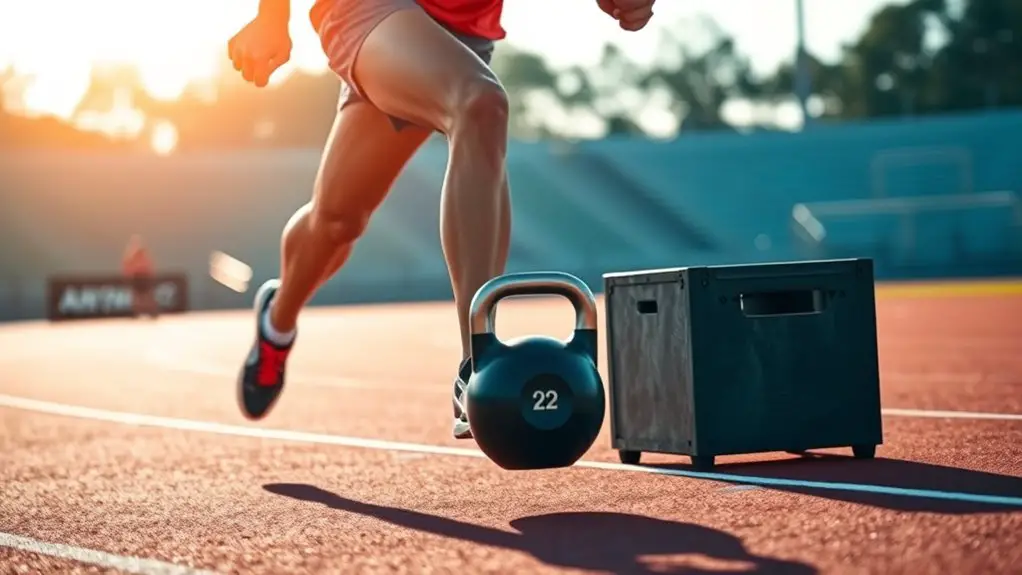To develop endurance for long shifts on the ice, focus on a balanced training regimen that combines cardiovascular and strength training. Incorporate interval drills, prioritize core stability, and fuel your body with proper nutrition to enhance performance. Don't overlook mental toughness; visualize success and practice positive self-talk to build resilience. Finally, implement recovery techniques to promote muscle repair and flexibility. There's plenty more to explore about optimizing your training and performance.
Understanding Endurance: The Basics
When you think about endurance, it's vital to recognize that it goes beyond just physical stamina; it also involves mental resilience. Understanding endurance types is essential for anyone looking to thrive, especially during long shifts on the ice. There are primarily two types of endurance: aerobic and anaerobic. Aerobic endurance relies on oxygen for sustained energy, while anaerobic endurance kicks in during high-intensity bursts. Each type taps into different energy systems, helping you push through fatigue and maintain performance.
To truly harness your potential, you'll want to train both types. This balance not only builds your physical strength but also sharpens your mental toughness. By focusing on endurance, you're not just preparing your body; you're liberating your mind from limitations. Embrace the journey of developing endurance, and you'll find the freedom to tackle any challenge that comes your way. Additionally, incorporating cross-training activities can enhance your overall stamina and reduce the risk of injury.
Importance of Cardiovascular Training
Cardiovascular training is essential for boosting your heart health and enhancing your stamina levels during long shifts. By incorporating activities like running or cycling into your routine, you'll not only improve your endurance but also support your overall well-being. Prioritizing this type of training can make a significant difference in how you handle extended hours on the job. Additionally, engaging in high-intensity interval training can effectively elevate your VO2 max, further enhancing your endurance capabilities.
Boosting Heart Health
Maintaining a healthy heart is essential, especially for those facing long shifts that demand physical and mental endurance. When you engage in cardiovascular exercises, you're not just building stamina; you're also reaping significant heart health benefits. Activities like running, cycling, or even brisk walking keep your heart strong and efficient, allowing you to tackle demanding shifts with ease. Plus, regular cardiovascular training enhances blood circulation, reduces stress, and boosts your overall energy levels. This means you'll be able to stay focused and alert, which is vital on the ice. So, embrace those heart-pumping workouts and feel the freedom that comes with a strong, healthy heart. Your body will thank you as you glide through those long shifts with confidence.
Enhancing Stamina Levels
To enhance your stamina levels, incorporating regular cardiovascular training into your routine is essential. This type of training boosts your heart and lung efficiency, allowing you to perform better during long shifts on the ice. Start by conducting a stamina assessment to gauge your current endurance levels. This can help you identify areas for improvement. Engage in activities like running, cycling, or swimming, and aim for at least 150 minutes of moderate-intensity cardio each week. As you progress, consider endurance testing to measure your advancements. Remember, the key is consistency; the more you train, the more stamina you'll build, giving you the freedom to skate longer and harder without fatigue. Embrace the challenge and enjoy the process!
Strength Training for Ice Performance
To excel on the ice, you need a solid foundation in strength training. Focusing on core stability exercises, lower body strength, and plyometric techniques can greatly enhance your performance. Functional Strength Training integrates these elements to ensure you develop the necessary power and agility for long shifts on the ice.
Core Stability Exercises
While you're training for ice performance, incorporating core stability exercises is essential for enhancing your strength and endurance. By focusing on core engagement, you'll not only improve your balance but also your overall stability on the ice. Here are some effective stability routines you can add to your workouts:
| Exercise | Reps/Time | Purpose |
|---|---|---|
| Plank | 30-60 seconds | Core strength |
| Russian Twists | 15 per side | Oblique engagement |
| Bird-Dog | 10 per side | Balance and stability |
| Side Plank | 30 seconds/side | Lateral stability |
| Dead Bug | 10 per side | Coordination and core |
Integrating these exercises will help you glide with greater confidence and freedom during those long shifts!
Lower Body Strength
Strengthening your lower body is essential for ideal ice performance, especially during long shifts when endurance is tested. Focus on leg workouts that build power and stability, allowing you to skate harder and longer without fatigue. Incorporate resistance training into your routine, using weights or resistance bands to challenge your muscles. Exercises like squats, lunges, and deadlifts target the key muscle groups you rely on for speed and agility on the ice. Don't forget to include variations to keep things fresh and engaging, which not only helps with strength but also keeps your mind free and motivated. By committing to a solid lower body strength program, you'll enhance your performance and enjoy those exhilarating moments on the ice even more.
Plyometric Training Techniques
Incorporating plyometric training techniques into your routine can markedly boost your ice performance by enhancing explosive power and agility. These exercises engage your fast-twitch muscle fibers, essential for quick bursts on the ice. Here are four effective plyometric techniques you should try:
- Plyometric Box Jumps: Jump onto a sturdy box to build leg strength and explosiveness.
- Depth Jumps: Step off a box and jump as high as possible upon landing to improve reactive strength.
- Lateral Bounds: Jump side-to-side to enhance your lateral movement and stability.
- Medicine Ball Slams: Use a med ball to develop upper body power and coordination.
Incorporating these techniques will not only elevate your game but also ignite that sense of freedom and speed on the ice!
Nutrition Strategies for Endurance
As you prepare for long shifts, nutrition plays an essential role in building your endurance. Focus on meal timing to guarantee your body's fueled before and after each game. Pre-game meals rich in carbohydrate loading can give you that energy boost, while post-workout recovery meals with quality protein sources will help repair muscles. Hydration strategies are imperative—stay ahead of thirst with water and electrolyte-rich drinks to maintain energy balance.
Opt for nutrient-dense snack options, like nuts or fruit, during breaks to keep your energy levels steady. Don't forget to take into account vitamin supplements; they can fill any gaps in your diet. Proper hydration is crucial for optimal performance, so being mindful of what you eat and when you eat can make a significant difference in how you feel on the ice. With these nutrition strategies, you'll harness the freedom to perform your best, no matter how long the shift lasts.
Mental Toughness: Building Resilience
While you may have the physical stamina to endure long shifts, mental toughness is just as essential for maintaining peak performance. Developing mental resilience can empower you to face challenges head-on and thrive under pressure. Here are some effective psychological strategies to enhance your mental game:
- Focus Techniques: Maintain concentration by breaking down your tasks into manageable segments.
- Visualization Exercises: Picture yourself succeeding in high-pressure situations to boost your confidence and preparedness.
- Positive Affirmations: Use empowering statements to reinforce your self-belief and enhance emotional regulation.
- Coping Mechanisms: Develop healthy outlets for stress management, like deep breathing or mindfulness, to keep your mind clear. Additionally, embracing a growth mindset allows you to view challenges as opportunities for improvement, further strengthening your mental toughness.
Recovery Techniques to Enhance Performance
To maintain high performance during long shifts, recovery techniques are essential, especially when fatigue sets in. Incorporate active recovery into your routine—low-intensity activities like light skating or jogging can boost circulation and ease muscle tension. Don't underestimate the importance of sleep; quality rest is vital for ideal recovery and mental clarity. Implement hydration strategies throughout your shifts to prevent dehydration, and focus on post-workout nutrition to replenish energy stores.
Utilizing recovery modalities like foam rolling and massage therapy can alleviate soreness and promote flexibility. Coupling these with breathing techniques helps calm the mind, enhancing mental recovery. Always prioritize injury prevention by listening to your body and adjusting your recovery practices as needed. Proper nutrition strategies can also significantly enhance your recovery process, ensuring your muscles are adequately repaired and ready for action. By integrating these strategies, you'll not only enhance your performance on the ice but also create a sustainable approach to long shifts that keeps you feeling your best.
On-Ice Drills to Improve Stamina
Recovery techniques lay the groundwork for enhancing your on-ice performance, but stamina drills are where you can really build endurance. By incorporating effective drills, you'll boost your stamina and feel more freedom on the ice. Here are some key exercises to take into account:
Recovery techniques set the stage for improved performance, but stamina drills truly enhance your endurance on the ice.
- Interval Sprints: Alternate between high-speed sprints and slower-paced skating to develop your pacing strategies.
- Figure-Eight Drill: Use this drill to improve agility and cardiovascular endurance by skating in a figure-eight pattern at varying speeds.
- Continuous Crossovers: Focus on maintaining a consistent pace while performing crossovers, building stamina through repetition.
- Lap Intervals: Skate laps at different intensities, mixing slow and fast segments to enhance your interval training.
Incorporating these drills will also help improve muscle efficiency in using oxygen, reducing fatigue during those demanding long shifts when it really counts. Each of these drills not only works your body but also sharpens your skills, preparing you for those long shifts when it really counts.
Creating a Personalized Training Plan
Creating a personalized training plan is essential for maximizing your endurance on the ice. Start by conducting personalized assessments of your current fitness level and skating skills. This'll help you identify strengths and areas needing improvement. Once you have a clear picture, focus on goal setting. Set both short-term and long-term goals that challenge you but are still achievable.
Next, structure your training around these goals. Incorporate a mix of on-ice drills, strength training, and cardiovascular workouts that align with your specific needs. Don't forget to include recovery periods; they're vital for building endurance. Additionally, consider integrating effective high-intensity interval training (HIIT) into your routine to boost both aerobic and anaerobic capacity.
As you progress, regularly revisit your assessments and adjust your plan as needed. Remember, the more tailored your approach, the more freedom you'll have to enjoy the game without feeling fatigued. Embrace the journey, and soon you'll find yourself gliding effortlessly through those long shifts!
Frequently Asked Questions
How Does Sleep Affect Endurance During Long Ice Shifts?
Imagine you're training for a marathon, but you're skimping on sleep. You'll likely feel fatigued and struggle to maintain your pace. Sleep quality is essential for endurance; it enables your body to recover and repair. By prioritizing rest, you can enhance your performance. Incorporating recovery strategies like napping or relaxation techniques can boost your energy levels, allowing you to tackle those long ice shifts with renewed vigor and confidence.
What Role Does Hydration Play in Maintaining Stamina?
Hydration's essential for maintaining stamina, especially during intense activities. You can't underestimate effective hydration strategies; they help keep your electrolyte balance in check. When you're well-hydrated, your body's processes run smoothly, allowing you to push through longer without feeling fatigued. Remember to sip water regularly and consider drinks with electrolytes to replenish what you lose. Stay free and energized by prioritizing your hydration, and you'll notice the difference in your stamina!
Are There Specific Supplements for Enhancing Endurance?
Imagine the rush of wind against your face as you power through your limits. When it comes to enhancing endurance, specific supplements can serve as energy boosters and performance enhancers. You might consider options like BCAAs, creatine, or even natural extracts like beetroot. These can help elevate your stamina and keep that freedom to push harder. Just remember, they're most effective when combined with a balanced diet and proper hydration.
How Can I Prevent Injuries During Endurance Training?
When you're focusing on endurance training, injury prevention is key. Start with proper warm up routines to prepare your muscles and joints, reducing the risk of strains or sprains. Incorporate dynamic stretches and light cardio to boost blood flow. Listen to your body; if something feels off, don't push through it. Gradually increase your training intensity, and make certain you have adequate rest days to let your body recover. Stay free and injury-free!
What Are the Signs of Overtraining in Endurance Athletes?
Did you know that about 10% of endurance athletes experience overtraining symptoms? If you find yourself feeling unusually fatigued, irritable, or seeing a drop in performance, you might be overtraining. Other signs include persistent soreness or disrupted sleep. To combat this, consider implementing recovery strategies like rest days, proper nutrition, and hydration. Listen to your body; it craves freedom from relentless training. Prioritize your well-being to keep thriving in your endurance journey!




